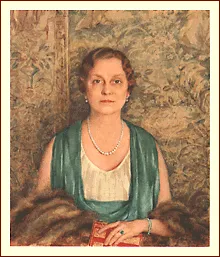Rachel Hunt was born on June 30, 1882, in Turtle Creek, Pennsylvania, and died in Pittsburgh on February 22, 1963. She had a strong affinity for plants, gardens, and books from her youth. These interests eventually led to her developing an internationally renowned collection of botanical books, manuscripts, and artworks. She began to collect books early in her special areas of interest. Her first gardening book, bought at age 15, was Leonard Meager's The English Gardener, or A Sure Guide to Young Planters and Gardeners, London, Printed for P. Parker, 1670.
She also became interested in bookbinding and studied with Euphemia Bakewell, a student of the English master binder T. J. Cobden-Sanderson. Her considerable mastery of the bookbinder's craft enabled her to produce approximately 90 bindings, many of which are now held by the Institute. Her binding activity is documented in Marianne Titcombe's The Bookbinding Career of Rachel McMasters Miller Hunt, Pittsburgh, 1974. She also began to collect rare books in earnest. In addition to books on plant-related subjects, she collected works on bookbinding, typography, and book production, as well as the products of selected private presses. Much of this non-botanical material resides in the Rare Book and Special Collections department of the Carnegie Mellon University Libraries.
A choice portion of her botanical book collection is documented in the two-volume Catalogue of Botanical Books in the Collection of Rachel McMasters Miller Hunt, compiled by Jane Quinby and published in Pittsburgh by The Hunt Botanical Library, 1958–1961.
In 1913, she married Roy Arthur Hunt, president and chairman of the Aluminum Company of America (Alcoa) and son of company founder Alfred E. Hunt. Together, they established the Rachel McMasters Miller Hunt Botanical Library, which was formally opened and dedicated on October 10, 1961.Rachel Hunt was active in and, in some cases, a founding or charter member of the following organizations: American Bookplate Association, American Horticultural Society, Garden Club of America, Garden Club of Allegheny County, Grolier Club, Herb Society of America, Hroswitha Club, National Society of Colonial Dames of America, Pennsylvania Society, Pittsburgh Bibliophiles, and Zonta International.
We feel fortunate to make Mrs. Hunt's collections and the Institute's subsequent acquisitions, research, and programs available to scientists, scholars, and anyone interested in the various aspects of botany, bibliography, art biography, and history represented here.
